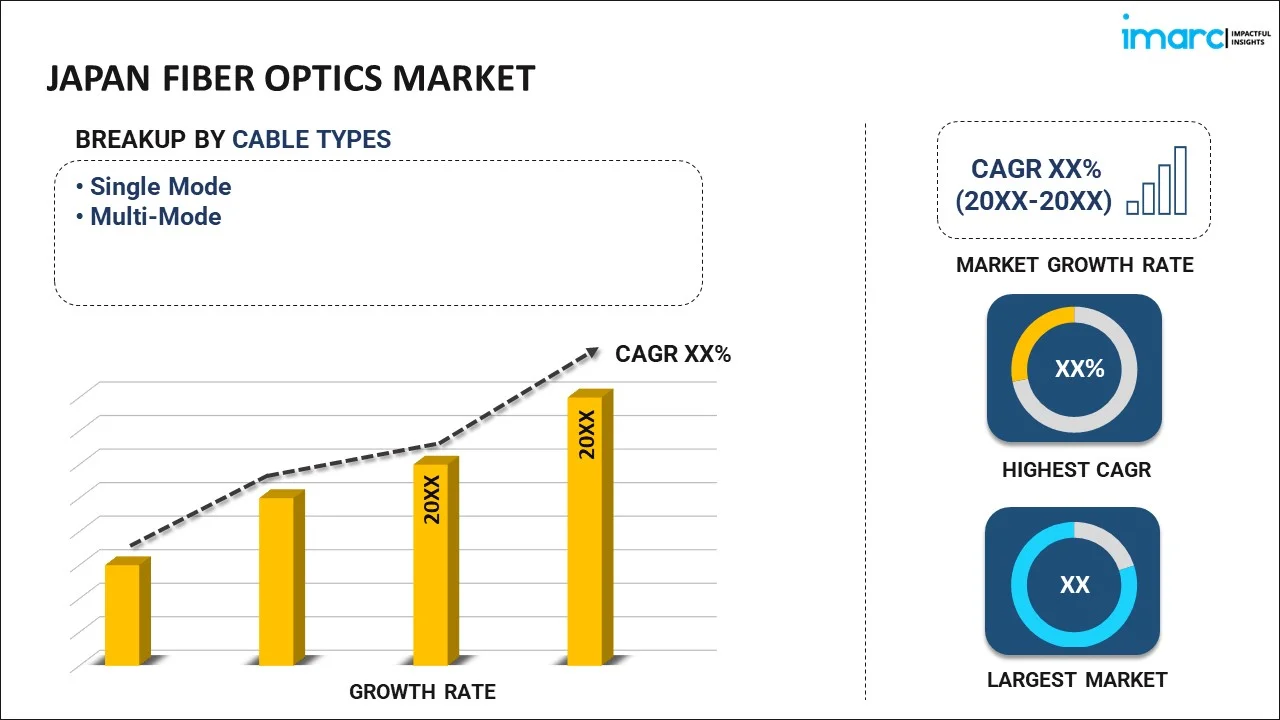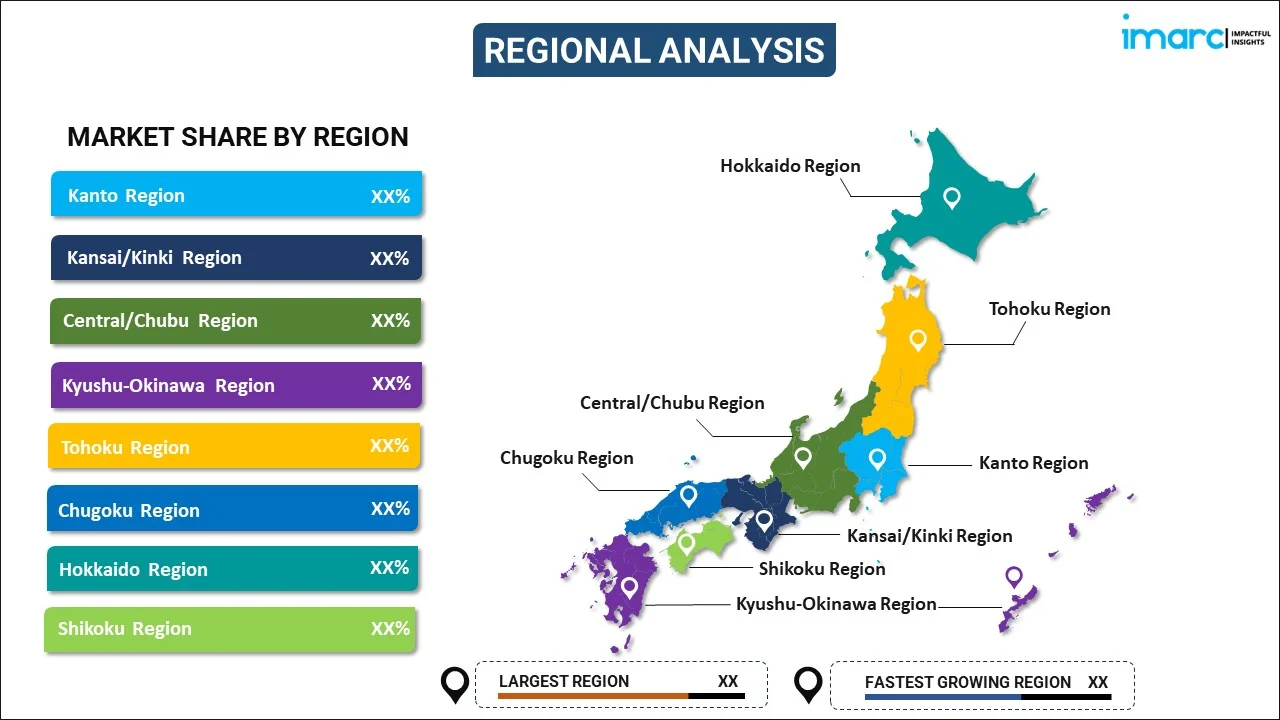
Japan Fiber Optics Market Report by Cable Type (Single Mode, Multi-Mode), Optical Fiber Type (Glass, Plastics), Application (Telecom, Oil and Gas, Military and Aerospace, BFSI, Medical, Railway, and Others), and Region 2025-2033
Market Overview:
Japan fiber optics market size reached USD 645.8 Million in 2024. Looking forward, IMARC Group expects the market to reach USD 1,864.0 Million by 2033, exhibiting a growth rate (CAGR) of 11.4% during 2025-2033. The market is being driven by several factors, including the growing demand for the product in renewable energy initiatives like wind farms and solar power plants, the increasing use of telemedicine and remote healthcare services, and the rising adoption of the product in surveillance systems.
|
Report Attribute
|
Key Statistics
|
|---|---|
|
Base Year
|
2024 |
|
Forecast Years
|
2025-2033
|
|
Historical Years
|
2019-2024
|
| Market Size in 2024 | USD 645.8 Million |
| Market Forecast in 2033 | USD 1,864.0 Million |
| Market Growth Rate (2025-2033) | 11.4% |
Fiber optics is an advanced technology that has revolutionized the field of communication and data transmission. It operates by utilizing slender strands composed of transparent glass or plastic fibers to transmit information through light signals. These fibers have the capacity to convey extensive volumes of data across substantial distances at remarkable speeds, delivering superior performance when compared to conventional copper cables. They come with a multitude of benefits, including high bandwidth, immunity to electromagnetic interference, and minimal signal loss. Fiber optics finds widespread applications in telecommunications, internet connectivity, data centers, and various industries that necessitate dependable and high-speed data transfer. The continuous evolution of fiber optic technology, including the development of fibers with higher capacity and enhanced connectivity solutions, propels its market growth and facilitates the seamless exchange of information in an increasingly interconnected world.
Japan Fiber Optics Market Trends:
The Japan fiber optics market is significantly propelled by the growing necessity for high-speed data transmission. This heightened requirement for swift and dependable internet connectivity has led to the expansion of broadband networks, driving the demand for fiber optics to support high-speed connections. Moreover, numerous telecommunication companies are investing in fiber optic networks to meet the surging demand for high-bandwidth communication services, exerting a positive impact on the market. Furthermore, the proliferation of data centers to facilitate cloud computing and storage relies on high-speed connectivity, making fiber optics an essential component of their infrastructure, thus catalyzing market growth. Additionally, the deployment of 5G networks necessitates robust and high-speed backhaul connections, further accelerating the demand for fiber optics in telecommunications infrastructure. Internet service providers (ISPs) are also upgrading their networks to deliver faster and more reliable internet services, thereby contributing to market expansion. Furthermore, ongoing advancements such as enhanced fiber capacity, improved signal quality, and more efficient installation methods extend the capabilities of fiber optics, fueling market growth. Several governments worldwide are making investments in broadband infrastructure and offering incentives to promote the adoption of fiber optics, further boosting market dynamics.
Japan Fiber Optics Market Segmentation:
IMARC Group provides an analysis of the key trends in each segment of the market, along with forecasts at the country level for 2025-2033. Our report has categorized the market based on cable type, optical fiber type, and application.
Cable Type Insights:

- Single Mode
- Multi-Mode
The report has provided a detailed breakup and analysis of the market based on the cable type. This includes single mode and multi-mode.
Optical Fiber Type Insights:
- Glass
- Plastics
A detailed breakup and analysis of the market based on the optical fiber type have also been provided in the report. This includes glass and plastics.
Application Insights:
- Telecom
- Oil and Gas
- Military and Aerospace
- BFSI
- Medical
- Railway
- Others
The report has provided a detailed breakup and analysis of the market based on the application. This includes telecom, oil and gas, military and aerospace, BFSI, medical, railway, and others.
Regional Insights:

- Kanto Region
- Kansai/Kinki Region
- Central/ Chubu Region
- Kyushu-Okinawa Region
- Tohoku Region
- Chugoku Region
- Hokkaido Region
- Shikoku Region
The report has also provided a comprehensive analysis of all the major regional markets, which include Kanto Region, Kansai/Kinki Region, Central/ Chubu Region, Kyushu-Okinawa Region, Tohoku Region, Chugoku Region, Hokkaido Region, and Shikoku Region.
Competitive Landscape:
The market research report has also provided a comprehensive analysis of the competitive landscape in the market. Competitive analysis such as market structure, key player positioning, top winning strategies, competitive dashboard, and company evaluation quadrant has been covered in the report. Also, detailed profiles of all major companies have been provided.
Japan Fiber Optics Market Report Coverage:
| Report Features | Details |
|---|---|
| Base Year of the Analysis | 2024 |
| Historical Period | 2019-2024 |
| Forecast Period | 2025-2033 |
| Units | Million USD |
| Scope of the Report | Exploration of Historical Trends and Market Outlook, Industry Catalysts and Challenges, Segment-Wise Historical and Future Market Assessment:
|
| Cable Types Covered | Single Mode, Multi-Mode |
| Optical Fiber Types Covered | Glass, Plastics |
| Applications Covered | Telecom, Oil and Gas, Military and Aerospace, BFSI, Medical, Railway, Others |
| Regions Covered | Kanto Region, Kansai/Kinki Region, Central/ Chubu Region, Kyushu-Okinawa Region, Tohoku Region, Chugoku Region, Hokkaido Region, Shikoku Region |
| Customization Scope | 10% Free Customization |
| Post-Sale Analyst Support | 10-12 Weeks |
| Delivery Format | PDF and Excel through Email (We can also provide the editable version of the report in PPT/Word format on special request) |
Key Questions Answered in This Report:
- How has the Japan fiber optics market performed so far and how will it perform in the coming years?
- What has been the impact of COVID-19 on the Japan fiber optics market?
- What is the breakup of the Japan fiber optics market on the basis of cable type?
- What is the breakup of the Japan fiber optics market on the basis of optical fiber type?
- What is the breakup of the Japan fiber optics market on the basis of application?
- What are the various stages in the value chain of the Japan fiber optics market?
- What are the key driving factors and challenges in the Japan fiber optics?
- What is the structure of the Japan fiber optics market and who are the key players?
- What is the degree of competition in the Japan fiber optics market?
Key Benefits for Stakeholders:
- IMARC’s industry report offers a comprehensive quantitative analysis of various market segments, historical and current market trends, market forecasts, and dynamics of the Japan fiber optics market from 2019-2033.
- The research report provides the latest information on the market drivers, challenges, and opportunities in the Japan fiber optics market.
- Porter's five forces analysis assist stakeholders in assessing the impact of new entrants, competitive rivalry, supplier power, buyer power, and the threat of substitution. It helps stakeholders to analyze the level of competition within the Japan fiber optics industry and its attractiveness.
- Competitive landscape allows stakeholders to understand their competitive environment and provides an insight into the current positions of key players in the market.
Need more help?
- Speak to our experienced analysts for insights on the current market scenarios.
- Include additional segments and countries to customize the report as per your requirement.
- Gain an unparalleled competitive advantage in your domain by understanding how to utilize the report and positively impacting your operations and revenue.
- For further assistance, please connect with our analysts.
 Inquire Before Buying
Inquire Before Buying
 Speak to an Analyst
Speak to an Analyst
 Request Brochure
Request Brochure
 Request Customization
Request Customization




.webp)




.webp)












